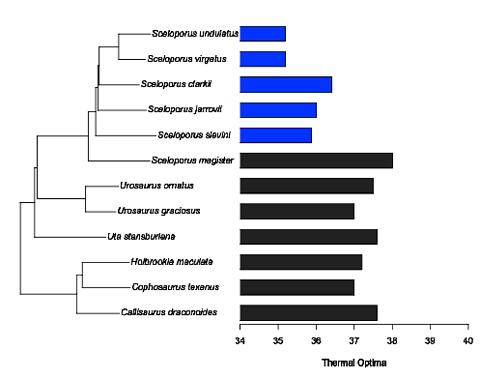Biological Sciences graduate student Anthony Gilbert was awarded the Division of Ecology and Evolution Raymond B. Huey Best Student Paper Award at the international Society for Integrative and Comparative Biology conference in Tampa, held Jan. 3-7.
Gilbert was selected from more than 70 applicants to present his talk in a session at the conference that consisted of him and six other students. The award comes with a $150 honorarium and a yearlong subscription to the journal Ecology Letters, and he is invited back to the conference next year to help review the 2020 applicants for the award.
His paper, “Thermoregulatory behavior and thermal physiology are evolutionarily uncoupled in Phrynosomatid lizards,” was co-authored with his adviser, Dr. Donald Miles, Professor of Biological Sciences at Ohio University.
Abstract: Identification of the proximate and ultimate sources of variation in physiological behavioral traits is necessary for predicting the responses of organisms to environmental change. On one hand, variation in the environment is known to affect behavior and physiology. Phylogenetic influences on behavior and physiology are also likely to play important roles in shaping both phenotypic differentiation and the responses of species to environmental change. An examination of the coevolution of behavior and physiology is rarely placed within both a phylogenetic and environmental context, however. Behavioral traits are much more labile and respond strongly to selective pressures than physiological traits, which are evolutionarily conserved. Because of the evolutionary mismatch in the mode and rate at which behavior and physiology co-evolve, one would predict that behavioral and physiological traits exhibit unique evolutionary optima that might constrain rapid adaptation to novel environmental change. In a case where behavior and physiology interact strongly, the evolutionary relationship between thermoregulatory behavior and thermal physiology can strongly influence adaptive and plastic responses of species to environmental change when phylogenetic or environmental constraints are weak. Here, we estimated complete thermal performance curves, thermal tolerance ranges, and thermoregulatory behavior for 12 species of Phrynosomatid lizards inhabiting the Sonoran Desert of southern Arizona. We incorporated global climate data to link evolutionary dynamics in thermoregulatory behavior and thermal physiology to background patterns of environmental temperature. Traits related to behavioral thermoregulation evolve much faster than thermal physiological traits. Behavioral traits evolve via Brownian Motion, whereas all physiological traits exhibit some evolutionary optima.
Thermal physiological traits exhibit larger values for phylogenetic signal than do behavioral thermoregulation traits. We also found that environmental constraints are stronger on traits related to thermoregulatory behavior, and that phylogenetic constraints are stronger on traits related to thermal physiology. When we modeled state-dependent shifts in thermoregulatory behavior as a function of thermal physiology, we found that no physiological trait influenced the tempo at which thermoregulatory behavior evolved. These findings reinforce the observations that physiological traits are evolutionarily conserved whereas behavioral traits are labile, and this relationship allows both sets of traits to evolve independently. Theory predicts that behavior and physiology should coevolve such that ectothermic organisms maintain a narrow range of body temperatures to optimize physiological function. However, as environmental change selects for different combinations of behavioral and physiological traits, evolutionary mismatches between these sets of traits can become exaggerated and result in novel phenotypic trajectories at multiple organismal scales. We also reinforce the pattern that behavior exhibits much stronger ties to the environment whereas physiology exhibits stronger phylogenetic structuring independent of environmental differences among species. As behavioral traits are constrained primarily through the environment and physiological traits are constrained primarily through phylogeny, the relationship between behavior and physiology is detected only at the species and not clade level, which provides a novel perspective on the coevolution of behavior and physiology.





















Comments